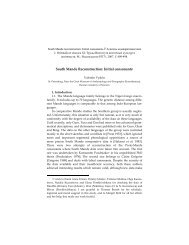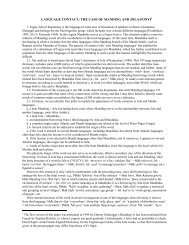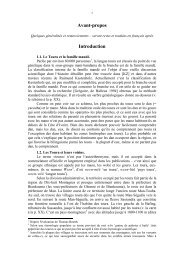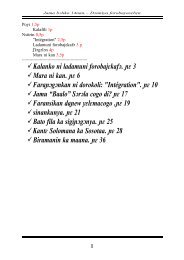by Dr Ross McCallum Jones July 2010 KYANGA (TYE)
Preliminary report on the Kyanga and Shanga, by Dr Ross ...
Preliminary report on the Kyanga and Shanga, by Dr Ross ...
You also want an ePaper? Increase the reach of your titles
YUMPU automatically turns print PDFs into web optimized ePapers that Google loves.
Preliminary Report on the Kyanga and Shanga people 107.0 PhonologyAs with other Mande languages of Nigeria and Benin there are 7 oral vowels, 5 of whichhave a nasalised form:Vowelsi e a ↄ o uↄConsonantsLabial Alevolar Velar GlottalPlosives b d g gbp t/c k kp „Fricatives f/h sv z /jNasals m n ŋFluids w l/r ySyllabic nasal / / ŋ1. Utterance nal / is generally pronounced as ).2. The glottal stop is a regular Kyanga consonant, but it is not written word initially inthe orthography. Medially it is represented <strong>by</strong> the apostrophe.3. Medial (d, t, l/r) are flapped. With the (l/r) opposition, only (l) occurs initially and (r)occurs intervocally, but morphemes that begin with (l) will maintain (l) intervocally andwill be reduplicated with (l). Some loanwords have (l) intervocally, which is maintained.At least one loanword begins with (r). Clitic postposition which are suffixed are realisedas(ru, ra). So both (l/r) are reagarded as phonemes and written in the orthography.4. /l,n/ are allophones of the same phoneme, but both are written to conform with thephonology of other languages. Their distribution is mutually exclusive as in theBoko/Busa languages, with /l/ being followed <strong>by</strong> oral vowels, while /n/ is followed <strong>by</strong>nasal vowels, although the nasalisation is not as strong as after other consonants.5. All plosives and the liquids/y,w/ are prenasalised to varying degrees when followed <strong>by</strong>nasal vowels, depending on the consonant and the speaker. y is completely prenasalisedand is always realised as / before nasal vowels, but is wtitten in the orthography as (y)with a nasal vowel following . Prenasalisation of /w/ is heard with some speakers./b, p, gb, kp/ are rather strongly postnasalised, while /d, t, g, k/ can be strongly nasalised<strong>by</strong> some speakers. This pre and post nasalisation is not shown in the phoneticrepresentation of words in the dictionary nor in the orthography.6. /s, z/ are consistently palatalised before the front vowels /i, e, z s









